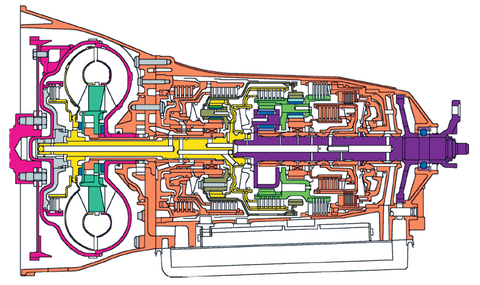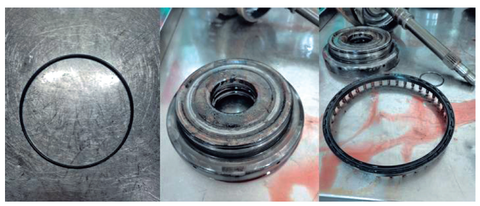[Repair Case] 2012 Jeep Wrangler cold car shift delay
Posted by Tony Brown on
Model: A 2012 Jeep Wrangler off-road vehicle equipped with a 3.6L engine and matches the 722.6 electronically controlled 5-speed automatic transmission produced by Mercedes-Benz. The mileage is about 170,000km.
Issue: Cold car shifting delay, 2-3 gears, 3-4 gears have a serious lag phenomenon, sometimes the second or third gear will be locked after a long driving time, and the transmission ratio error of the second or third gear will be reported when the gear is locked. The fault code of the valve has been replaced with a new valve body in the previous maintenance.
Diagnosis: P0732 and P0733 are used to read the fault codes with a diagnostic instrument. P0732 refers to the wrong gear ratio of the 2nd gear, and P0733 refers to the wrong gear ratio of the 3rd gear. Therefore, the possible causes of failures are analyzed based solely on the meaning of the failure code interpretation:
(1) The clutch itself has poor execution ability when the car is cold;
(2) There is leakage in the oil path between the valve body and the clutch;
(3) Problems with the valve body (the new valve body has been replaced);
(4) Signals that affect the shift time (engine load signal and vehicle speed signal).
Merely analyzing the definition of fault codes and the analysis of failure phenomena is not enough to directly lock the fault point. Therefore, we must fully understand the basic information of this 722.6 transmission produced by Mercedes-Benz, so as to provide more direct fault analysis and fault judgment. The 722.6 transmission is a 5-speed fully electronically controlled transmission independently developed by Mercedes-Benz (as shown in Figure 1). It is mainly used in most Mercedes-Benz models after 1996. Some models of Chrysler, including Jeep Wrangler and other models are also in use. The transmission control unit performs a comprehensive analysis based on the accelerator pedal position, vehicle speed, engine speed, transmission temperature and other information provided by the two speed sensors in the transmission and the controller area network (CAN), and through 3 shift solenoid valves, Two pressure regulating valves and one TCC lock-up control solenoid valve determine the timing of shifting up or down and the timing of the engagement and disengagement of the torque converter lock-up clutch. And its torque converter lock-up clutch is a multi-disc clutch hub type, so it can only work normally when it receives system oil pressure.

From the basic inspection, the transmission ATF is in good condition, indicating that the internal mechanical components have not been ablated. You must know that the new valve body has been replaced in other repair shops. This shows that even if it is possible that the transmission has not been disassembled for overhaul, it must indicate that the friction plate There should be no ablation, which means that the ATF has been kept in good condition during the previous maintenance, and of course it has been replaced with a brand new one. If analyzing from the fault code, it should be that the transmission itself is more likely to have a fault. Of course, the fault code caused by other reasons cannot be ruled out. In terms of the fault phenomenon reported by the user for repairs, the automatic transmission itself is delayed by the control unit of the shifting time in the low temperature state, but the shifting of this car is too delayed. For the electronically controlled automatic transmission, the shift delay fault is not only caused by the automatic transmission itself, but also mainly related to the engine power, load information, ABS and other information.
No matter what causes it, we still have to try the car well, so we left the car overnight (which coincides with the colder days in winter), and started the test early the next morning. During the test drive, it was found that all gears were delayed when the transmission was upshifting, but the delay of 2-3 gears was longer. When the accelerator pedal was released, the vehicle speed reached the third upshift. The condition is that the gears are delayed and the transmission lock is slightly ignored. The fault code read is either P0732 or P0733; because the 3-4 gear is also quite lagging. After running for about 20km, the transmission upshift seems to be relatively normal. Normally, the fault code will not reappear no matter how to test the car. The automatic transmission oil volume meets the standard requirements, and the oil quality is not found to be abnormal due to hardware damage. Could it be the engine problem that caused the delay in shifting between 2-3 and 3-4 gears? Due to the long dwell time in the second or third gear, the transmission control unit reports an error in the transmission ratio of the second or third gear. Therefore, you should focus on checking the engine status after the test.
After inspection and continuous testing, it is found that the engine system always reports a P 0 0 1 6 fault code. There are multiple fault codes at the beginning of the test. After deletion, only P 0 0 16 remains, but P 0 0 1 6 can also be deleted. But it will appear after driving. Is P0016 the main cause of shift delay?
Later, after deleting the P0016 fault code and testing, a new clue was found, that is, through the data stream, it was seen that the throttle opening signal did not correspond to the actual accelerator pedal position. It is normal when the accelerator pedal is not stepped on, but the data collected by the diagnostic instrument is 3.9% when the accelerator pedal is stepped on about 1/4, and the engine speed is almost 1800r/min when the accelerator pedal is stepped on halfway, the throttle signal only reaches 6.7%, when the accelerator pedal is fully depressed, the throttle signal is 39.2%. Anyway, we must check the throttle.
After checking and cleaning the throttle, a new fault code appeared, and the acceleration could not be directly performed, the accelerator pedal was restricted, and the vehicle could not be tested. After re-matching the throttle, it resumes the starting state, and the shift time remains unchanged from the original. Two parts of the valve body have been replaced, one of which is still brand new. To solve this shift delay fault, we also learned from the owner that the engine line was also changed. That is to say, the engine factor is almost no need to consider. It is the repair shop who is not particularly professional in transmission and finally found us.
Neither repair the engine nor dismantle the transmission before there is no maintenance idea but should focus on carefully testing the car again. Because the transmission is basically normal after the car is hot (at least 20km in the morning), the normal performance of the vehicle is about 1/4 throttle, and the 1-2, 2-3, and 3-4 gears can also be in 200 0r. /min to complete the gear shift (of course not driving on a very steep slope). Through the comparison test of the cold and hot cars, it is found that the engine speed is higher when the cold car is not shifting, and the speed rises very slowly (should be slipping). Although the electronically controlled automatic transmission has the function of cooling and heating (postponing the shift time), it is obvious that in a fixed gear (2nd or 3rd gear) even if it is not upshifted, at least from the perspective of the transmission ratio, the vehicle speed corresponds to the transmission ratio. The other is to find a steep slope and high throttle to start or let the transmission drive in 2nd and 3rd gears. At this time, the fault codes of the wrong gear ratios of 2nd and 3rd gears are easily activated. This fully shows that part of the engine speed is lost when the car is cold. If there is no loss, then the vehicle speed will increase significantly, so that the transmission control unit will issue an upshift command after the vehicle speed reaches the upshift condition. Loss of engine speed indicates that there is slippage inside the transmission. Therefore, it seems that the control module reports P0732 and P0733 fault codes for a reason, that is, the 2nd and 3rd gears slip when the car is cold. Next, find the data and analyze the participating components of the 2nd and 3rd gears.
2-3 gear delay means that both K1 and K2 clutches have problems (analyzed according to the 722.6 transmission shift element application table). Because the code is not reported when the cold car is in the 1st gear, it means that there should be no problem with the execution ability of the components K3 and B2 shared with the first gear. At the same time, the cold car does not report the code in the 4th gear for a long time, so the K3 problem is not big, and the final focus is on K1 And K2 execution ability.
Troubleshooting: After disassembling the transmission, it is found that all the seals of the transmission are particularly hard (as shown in Figure 2). Both the rubber seal ring and the rubber piston are particularly stiff. One of the seal rings is as hard as a steel wire, so the problem is finally found. Fortunately, the friction plate did not burn. It seems that the transmission has had a high temperature in the past. Of course, the mileage and time have been so long, and the seals are also aging, so the leakage is too large when the car is cold, which causes the shift delay. When the control unit detects slippage, it triggers the fault code to be set. After replacing the piston, seals, and friction plates (although they were not burnt, they were replaced to ensure the quality of maintenance) and the fault was completely eliminated.

Summary: The failure of this transmission is not a difficult failure from the maintenance results, but the previous maintenance has replaced the new valve body, so everyone does not consider the internal components. The test method in this case played a decisive role. The ATF is in very good condition and the friction plate is not ablated. Therefore, everyone believes that there must be no mechanical problems inside the transmission. The main focus is actually the correspondence between engine speed and vehicle speed. The throttle signal seen before: First, it may be like this; second, it may be related to the diagnostic equipment used, but it is just a small episode.
